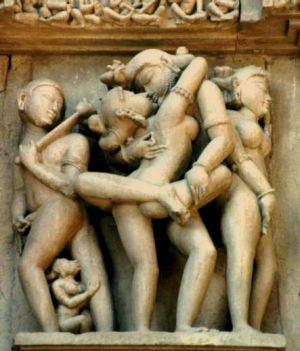Khajuraho Group of Monuments: Difference between revisions
No edit summary |
meta>Water Fish reverting extreme vandalism (page blanking) by 67.173.151.238 to the last version by Tom Radulovich |
||
| Line 1: | Line 1: | ||
[[Image:Khajurahosculpture.jpg|thumb|right|Sculpture from a temple at Khajuraho]] '''Khajuraho''' is a city in the [[States and territories of India|Indian state]] of [[Madhya Pradesh]], located about 385 miles (620 kilometres) southeast of [[Delhi]], the capital city of [[India]]. | |||
One of the most popular [[tourist destinations in India]], Khajuraho has the largest group of [[medieval]] [[temple]]s famous for their [[erotic sculpture]]. The name Khajuraho is derived from the [[Hindi]] word ''khajur'' meaning a ''date palm''. | |||
The city was once the religious capital of the [[Chandela]] [[Rajput]]s, a tribal dynasty who ruled this part of India from the 10th to the 12th centuries. The Khajuraho temples were built over a span of a hundred years, from 950-1050 AD. The whole area was enclosed by a wall with eight gates, each flanked by two golden palm trees. There were originally over 80 temples, of which only 22 now stand in a reasonable state of preservation, scattered over an area of about 8 mile² (21 km²). | |||
The Khajuraho group of monuments has been listed as a [[UNESCO]] [[World Heritage Site]]. | |||
==External link== | |||
* [http://www.virtualtourist.com/m/23e1c/10b5e3/ Photos of Khajuraho temples] | |||
[[fr:Khajurâho]] | |||
Revision as of 23:24, 12 August 2004

Khajuraho is a city in the Indian state of Madhya Pradesh, located about 385 miles (620 kilometres) southeast of Delhi, the capital city of India.
One of the most popular tourist destinations in India, Khajuraho has the largest group of medieval temples famous for their erotic sculpture. The name Khajuraho is derived from the Hindi word khajur meaning a date palm.
The city was once the religious capital of the Chandela Rajputs, a tribal dynasty who ruled this part of India from the 10th to the 12th centuries. The Khajuraho temples were built over a span of a hundred years, from 950-1050 AD. The whole area was enclosed by a wall with eight gates, each flanked by two golden palm trees. There were originally over 80 temples, of which only 22 now stand in a reasonable state of preservation, scattered over an area of about 8 mile² (21 km²).
The Khajuraho group of monuments has been listed as a UNESCO World Heritage Site.